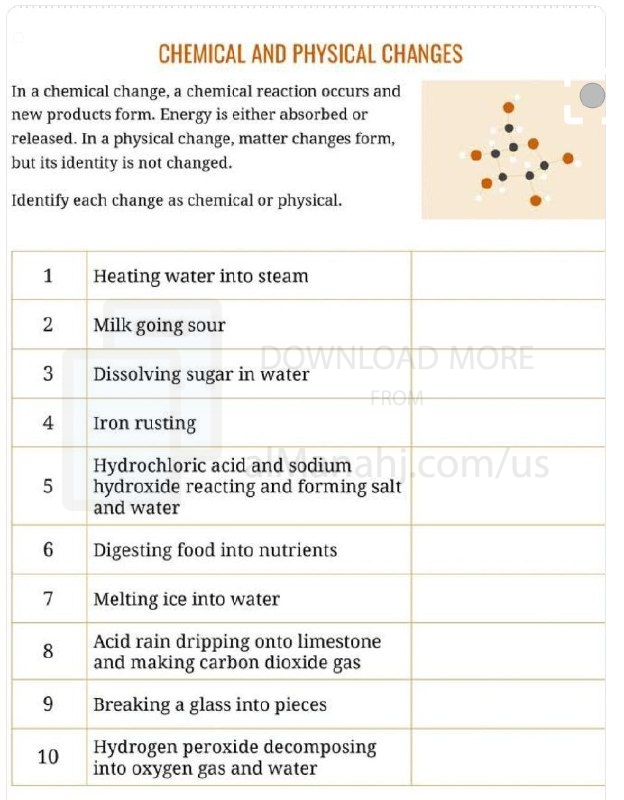File info: A worksheet about chemical and physical changes is a learning resource designed to help students understand the distinction between chemical and physical changes in matter. The worksheet aims to provide examples and activities to facilitate comprehension of the characteristics and differences between these two types of changes. Here's a description of what a worksheet about chemical and physical changes might include:
1. Introduction to Chemical and Physical Changes: The worksheet begins with an introduction to the concepts of chemical and physical changes. It explains that changes in matter can be categorized into two types: chemical changes, which involve the formation of new substances with different properties, and physical changes, which involve alterations in the physical appearance or state of matter without the formation of new substances.
2. Characteristics of Chemical Changes: The worksheet outlines the key characteristics of chemical changes. It emphasizes that chemical changes often involve the release or absorption of energy, such as heat or light. It also highlights that chemical changes are usually irreversible, meaning it is difficult or impossible to revert the substances back to their original form. Examples of chemical changes, such as combustion or the rusting of iron, may be provided to reinforce understanding.
3. Characteristics of Physical Changes: The worksheet then discusses the characteristics of physical changes. It explains that physical changes do not result in the formation of new substances and that the chemical composition remains the same. Physical changes primarily affect the appearance, shape, size, or state of matter. Examples of physical changes, such as melting, freezing, or dissolving, may be provided to illustrate these concepts.
4. Differentiating Chemical and Physical Changes: The worksheet provides activities or questions that require students to differentiate between chemical and physical changes. Students may be presented with various scenarios or examples, and they need to determine whether each change is chemical or physical. This exercise encourages critical thinking and the application of knowledge to real-life situations.
5. Observing and Identifying Changes: The worksheet may include experiments or observations that allow students to witness and identify chemical and physical changes firsthand. For example, students may observe the reaction between certain chemicals or the changes in matter during heating or cooling processes. They are then prompted to describe and categorize these changes as chemical or physical.
6. Summary and Reflection: The worksheet concludes with a summary of the key points covered, reinforcing the differences between chemical and physical changes. It may include reflection questions that encourage students to think about the practical implications and importance of understanding these concepts in various scientific disciplines or everyday life.
The purpose of the worksheet is to deepen students' understanding of chemical and physical changes in matter. By providing examples, activities, and opportunities for observation, the worksheet aims to enhance their ability to differentiate between these types of changes and apply this knowledge in scientific contexts. |
